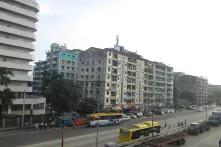Change is all around us; experiencing it can be exciting or worrisome, confusing or even disturbing. By contrast, the idea of “transition” stands to provide a sense of direction, in a sea of change and insecurity. Change may be happening to us; a transition has direction, it can be planned, perhaps even be initiated. It moves into a positive, sustainable direction – or so we hope. The equivalent German term “Wende” and its numerous composite terms play a prominent role in the programme of the German Green and in the international work of Heinrich Böll Stiftung (hbs).

This issue of Perspectives Asia showcases how partners, friends and fellow travellers of hbs in Asia look at and participate in these ongoing transition processes.
The transition to digital technologies – ubiquitous in Asia – produces sometimes surprising and ambiguous effects. While digital tools are widely used by government and businesses in China, Haili Cao shows how digital networking has contributed to the building of real-life communities under the Covid-19 lockdown in Shanghai. Perhaps these new connections will last.
Digitalisation also creates new ways to address problems faced by ageing societies, especially the increasing need for care work, much of which traditionally provided by women. Miyako Takagi looks at the use of artificial intelligence and robotics in this sector in Japan, where such technology use is perhaps most advanced. She also notes that some applications turn out to reproduce traditional gender stereotypes, while others – especially in the world of care – appear largely “gender-neutral”.
The ageing society is only one – the later – stage of the larger demographic transition, the process by which societies move from high population growth to often very low birth rates. While this basic pattern applies to most societies on Earth, different countries in Asia find themselves in very different stages of the process and face different challenges accordingly.
Pakistan, for example, has a very large population of young people, and Mome Saleem points at the policy needs especially in education and training to make this “demographic dividend” work for the people of the country.
All the while, South Korea has undergone the demographic transition rapidly, while achieving OECD standards of economic development in just a few decades. However, gender relationships remain highly inequitable, as women earn less and continue to bear the brunt of house and care work. Sunhye Kim points out that these very patterns of inequity result from South Korea’s “ultra-low fertility rate” today. She argues that instead of pronatalist policies pursued by conservative governments, South Korea needs a focus on reproductive health and rights for everybody.
The combination of rapid population and urban growth, expanding education and the availability of new role models provided by the culture industry have much increased the degree of individual choice to engage in personal relationships among Asia’s youth. But problems remain: Neha Dabhade shows for India how this freedom has come under attack as a part of an aggressive and often violent form of Hindu nationalist politics.
While the Indian case points to risks faced by Asia’s largest democracy, the evidence for a broader transition to democracy on the continent remains ambivalent at best. While some of East Asia’s former authoritarian “developmental states” have emerged into robust democracies, recent election results in the Philippines raised fears of regression or even a return to authoritarianism, as analysed by Cleo Calimbahin. Much worse, however, is the case of Myanmar, for which Su shows how the military coup on 1 February 2021 that ended the country’s fledgling democratic transition amounted to an outright social and economic disaster.
Beyond the large-scale trends, there is always the possibility and practice of transition as a deeply personal affair. In an interview, Hong Kong activist Kaspar Wan talks about his experience of becoming a transman and the transgender rights movement in the city. Miguel Jeronimo’s photostory captures moments of the lives of Cambodians who celebrate their abilities instead of their limitations, focusing on their journey of empowerment and crafting a life of independence for themselves.
Last, but not least, this issue of Perspectives Asia looks at perhaps the most archetypical “green” transition of all: the energy transition required to combat climate change. It does not only require political will and capital to invest into renewables, but needs to get the details rights. Taking observations from South East Asia, Laurence Delina shows what is required to make the energy transition a participatory and fair process for local and indigenous communities. And while energy planners in many countries have vast expectations about the future role of “green hydrogen” in the energy transition, Dongjae Oh points at the pitfalls of South Korea’s current hydrogen strategy that risks to increase, rather than reduce fossil fuel emissions.
Our thanks go to all contributors reporting from Asia in transition.
Axel Harneit-Sievers & Yoyo Chan
Hong Kong, February 2023


